Top News
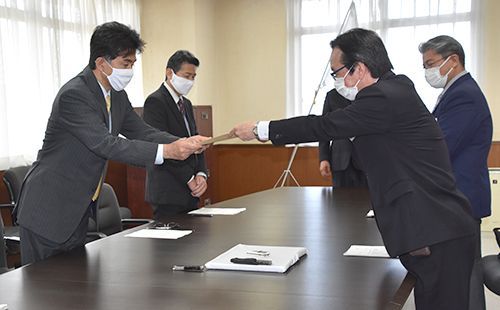
March 18, 2021 Ryukyu Shimpo
Due to aircraft noise and a foul odor coming from Kadena Air Base and increasing in severity on and after March 15, Mayor Hiroshi Toyama of Kadena Town visited Director General Toshinori Tanaka of the Okinawa Defense Bureau at said Bureau on March 17 and requested a reduction in the base burden on residents in areas surrounding the base. Director General Tanaka said that, in response to the strong request that the U.S. military keep its influence on residents of areas surrounding the base to a minimum, a U.S. military spokesperson mentioned that the increase in the use of aircraft was for maintaining quick-response capabilities, and that the use of 18th Air Wing aircraft would return to normal by the weekend.
At the beginning of the week in Kadena Town, noise from the takeoffs and landings of fighter aircraft intensified, particularly in the early morning. Occurrences of noise increased two- to five-fold compared to the week prior. Starting at 6:39 a.m. on March 15 at Rotary Plaza, noise met or exceeded 70 decibels, which is the level of a noisy street, 175 times. There was also a large-scale increase in the number of complaints brought to the Kadena Town government compared to the week prior.
Mayor Toyama stated, “The noise these days is intolerable. Please do not force the townspeople to bear even greater burdens from the base,” and requested effective countermeasures against the noise.
(English translation by T&CT and Erin Jones)
Go to Japanese
March 16 2021 Ryukyu Shimpo
We must take full advantage of this letter. The Overseas Base Realignment and Closure Coalition, a group of U.S. intellectuals, former officials, and others, published a letter addressed to President Biden calling for closure of U.S. military bases overseas. The signatories have taken issue with the new base construction in Henoko, Nago and the excessive burden of bases in Okinawa.
The letter takes issue with the increased military tensions and environmental destruction caused by U.S. bases overseas. It asserts that closure of overseas bases will reduce the fiscal burden on the U.S. and contribute to the domestic economy.
For Okinawa, suffering under an excessive burden of bases, these views and perspectives are highly important. Solidarity with this movement will surely lead to new initiatives aimed at stopping the new base construction in Henoko and reducing the burden of bases. We hope to see the Okinawa prefectural government, which opposes the new base, take this letter as an opportunity for renewed international solidarity.
This recommendation follows a previous one in 2018. They have come against a backdrop of reduced budgets for domestic education and social services for the sake of massive spending on building and maintaining bases overseas. U.S. bases also serve to increase tensions with China, Russia, and other neighboring countries.
Representatives of the Quincy Institute, a think tank established with funding from two wealthy donors, also signed on to the letter. The two donors were George Soros, a well-known liberal, and Charles Koch, a libertarian who supports “small government” and renounces military intervention overseas, the two having opposing political views. The institute emphasizes this moment as a “once-in-a-generation opportunity to bring together like-minded progressives and conservatives”.
Despite their divergent beliefs, the two agree that the U.S. should engage in restrained exercise of military force, stop “endless wars” in the Middle East and alter its diplomatic policy.
In fact, the U.S. has reduced the number of military bases it has overseas. The more than 2,000 overseas U.S. military facilities that existed in 1945 were reduced after the Vietnam War and after the Cold War, and now stand at around 800.
U.S. bases in Japan, however, mostly tend not to be subject to reduction. This is because Japan pays a high proportion of the costs required to station U.S. troops. The cost paid by Japan for U.S. forces stationed in Japan (the so-called “omoiyari yosan (sympathy budget)”) reached 201.7 billion JPY per year in fiscal 2021. The massive costs paid by the Japanese government are well appreciated by the U.S. military, and serve as an obstacle to closure and downsizing of the U.S. military bases in Okinawa and other parts of Japan.
The budget for building and maintaining military bases is huge for Japan as well. Japan’s defense budget reaches 5 trillion and some hundred billion JPY per year. According to the Okinawa prefectural government’s estimate, the cost for the new base in Henoko will be 550 billion JPY. The government has been spending some 26 million JPY per day for security in relation to the new base construction. Of the total construction cost of 930 billion JPY presented by the national government, roughly 170 billion, or around 18%, is associated with security costs, an amount equal to the cost of one Maya-class destroyer. This budget allocation can only be said to be absurd.
Moreover, the world is now facing an unprecedented pandemic with Covid-19. Now, with huge costs required for infection prevention and economic measures, is not the time to be spending massive amounts of taxes on military bases that will provoke other countries and raise tensions. We must escape from this negative spiral in which the more weapons are developed and deployed, the more other countries react, leading to an arms race. We should shift to a diplomatic policy emphasizing dialogue requiring no military cost.
(English translation by T&CT and Sandi Aritza)
Go to Japanese
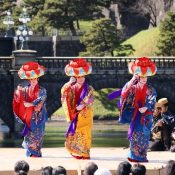
March 16, 2021 Ryukyu Shimpo
Tokyo – The Japan Cultural Expo Imperial Garden Special Dance Performance “Inori no kachi” (hosted by the Agency for Cultural Affairs, Ministry of the Environment, and the Japan Arts Council) was held March 14 on a specially constructed stage in front of the Imperial Palace and Nijuubashi, where a Ryukyuan dance was performed in prayer for the reconstruction of Shuri Castle, which was destroyed in a fire.
The exhibition was part of the “Japan Cultural Expo” cultural program run by the Japanese government. Dances such as “Yotsutake,” “Zei,” and “Shundo” were elegantly performed under a clear blue sky by Yukichi Agarie, Sato Shingaki, Seigi Tamagusuku, and Shigeo Miyagi. Against the backdrop of the palace’s stone walls and moats, the spectators enjoyed the Ryukyu Kingdom era dances that had an atmosphere reminiscent of the Ryukyuan missions to Edo.
After the performance, Agarie said, “I filled my dance with prayer for the reconstruction of Shuri Castle. It reminded me of the Ryukyuan missions to Edo, and was a good experience.” Shingaki said, “I want to pass down the Ryukyuan dance to the next generation, preventing it from going extinct.”
In addition to the Ryukyuan dances, which were performed on the final day of the exhibition, which opened on March 12, there were also Kyogen and short Noh plays performed by masters.
(English translation by T&CT and Sam Grieb)
Go to Japanese
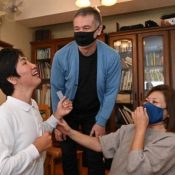
March 10, 2021 Ryukyu Shimpo
On March 10, entrance exam results were announced for Okinawa Prefectural High Schools and Special Needs Schools. Iori Nakamura, who has a severe intellectual disability and is now in his fourth year of taking entrance exams, was accepted into Mawashi High School. He applied through the Yui Classroom (Yui Kyoshitsu) system that was established this year for individuals with intellectual disabilities.
Nakamura’s registration is at Shimajiri Special Education School, but he will be attending Mawashi High School.
Nakamura first took the high school entrance exams in March 2017 as an individual with a severe intellectual disability. He was unsuccessful. Over the next three years until 2020, Nakamura failed the high school entrance exams six times, including second application periods. In the interim, his family negotiated with the Okinawa prefectural board of education for reasonable accommodations based on an understanding of his disability.
Just past 9:15 a.m. on March 10, Nakamura checked the exam results on the school homepage. Comparing his exam registration number with the number on the screen, Nakamura said, “It’s the same!”
(English translation by T&CT and Ellen Huntley)
Go to Japanese
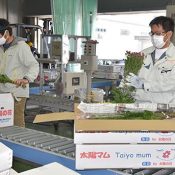
March 12, 2021 Ryukyu Shimpo
With the Japanese holiday Higan approaching in March, the busiest time of the year has come for shipping Okinawa-grown chrysanthemums. The chrysanthemums, which are used to adorn graves and Buddhist shrines, has seen a relatively minor impact from the COVID-19 pandemic, and advance orders are doing quite well. In addition to the regular transport flights, ANA will be operating additional cargo planes on March 10 and 13 from ANA, and JAL will be doing the same March 14.
The March chrysanthemum shipping volumes are expected to be down 12% cases compared to the previous year at 182,000 cases, due to heavy rain during the planting period last October, and insufficient sunlight in December, and other plants are expected to ship an average 10,000 cases. The revenue from these shipments is forecasted to be around 1.5 million yen.
Chrysanthemums are trending downward in terms of demand, as important family ceremonies grow smaller in scale. In particular, the coronavirus pandemic has curtailed the size of funeral services. Shigeyuki Miyagi, chairman of the Okinawa Floriculture Agricultural Cooperative (OFAC), producers of the “Flowers of the sun” brand, said, “I hope people want to buy these flowers for Higan, important farewells, and moments like leaving home to start a new life. I want to help heal people souls by decorating their houses with even a single flower.”
(English translation by T&CT and Sam Grieb)
Go to Japanese
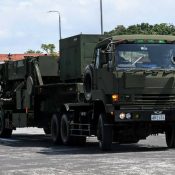
March 10, 2021 Ryukyu Shimpo
On the morning of March 10, the Japan Air Self-Defense Force (JASDF) stationed at Naha Air Base in Okinawa conducted, at Kadena Air Base, its first mobilization/deployment training with the Patriot Advanced Capability (PAC-3) surface-to-air missile system. The training was conducted despite objections and requests from the Kadena Air Base Tri-City Intercommunication Committee (chaired by Mayor Hiroshi Toyama of Kadena Town), which is comprised of people from local municipalities.
According to several interested parties, the PAC-3 system located at Chinen Sub Base in Nanjo City was moved to Kadena Air Base, and was involved in a series of operation trainings ranging from deployment to dismantling. The training was wrapped up in the morning, and the PAC-3 system was moved from Kadena Air Base after 1:00 p.m. the same day.
A JASDF spokesperson mentioned that the training was conducted on U.S. military base grounds that are managed by the U.S. military and used jointly, but the training itself was not joint training and was solely for the JASDF. Hereafter, a policy is being rolled out for nationwide deployment so that similar training can be conducted outside of Japan Self-Defense Force (JSDF) facilities.
Mobile deployment training for leaders is being planned for March 15, in which 10 vehicles and about 20 people of the Southwestern Aircraft Control and Warning Wing from Naha Air Base will participate.
◆ Okinawa prefectural government also requests sufficient consideration be given to citizens’ daily lives
On March 10 in a phone call with the Coordination Division of the Okinawa Defense Bureau’s Department of Planning, Atsushi Shiroma, a deputy councilor of the Military Base Affairs Division of the Okinawa prefectural government (OPG), requested that there be conscientious explanations so that regional understanding and cooperation can be achieved, and that sufficient consideration be given to citizens’ daily lives, safety, and peace of mind as affected by the training being conducted. Touching on the topic of the objections and requests from the Kadena Air Base Tri-City Intercommunication Committee, and speaking as a representative of the OPG, Shiroma expressed that there must not be an increase of the burden born by the Okinawan people due to training being conducted for joint-use of bases.
(English translation by T&CT and Erin Jones)
Go to Japanese
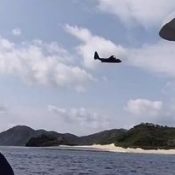
March 12, 2021 Ryukyu Shimpo
On March 10, two large aircrafts believed to be U.S. Air Force special operations aircraft MC-130J were observed flying at low altitudes off the coast of Zamami Island. According to eyewitnesses, the two planes flew west over the inland sea between Zamami Island and the Amuro, Agenashiku, and Gahi Islands located to the south, at around 10:20 a.m.
The two planes were flying above a route frequented by ferries and high-speed boats. Chihiro Hara, 33, a resident of Zamami Island, encountered the scene on her way to go whale watching and shot video footage of one of the planes on her smartphone. Hara said, “Just as we were departing Zamami Port, two aircraft suddenly flew towards us making a loud noise. They were flying at about a height of fewer than 30 meters above sea level.”
(English translation by T&CT and Monica Shingaki)
https://youtu.be/StrJmzmZSc0
Go to Japanese

March 8, 2021 Ryukyu Shimpo
A rainbow in the night sky, called a “moon rainbow (gekkou),” appeared at Okuma Beach in Kunigami Village, Okinawa. Akira Oyama, age 57, who serves as a nature guide in the village succeeded in capturing a photograph of the rainbow on March 1. According to the Okinawa Regional Headquarters of the Japan Meteorological Agency (JMA), it is extremely rare for a “moon rainbow” to be observed, and according to a representative of the Headquarters, “I have never seen a record of [such a rainbow] being observed in Okinawa Island.” In 2016, a “moon rainbow” was observed by the Ishigaki Astronomical Observatory.
A “moon rainbow” appears by refraction of moonlight in water droplets in the atmosphere. It is said that this can only occur when the night sky is dark and the air is clear.
Mr. Oyama discovered the rainbow as he was on his way home from an advance visit to a location where he would be visiting as part of his guide activities. He says that at first it appeared as a white arch, but as the strong light of the moon came through from between the clouds, the arch changed to have seven colors. “In Hawaii, it is said that seeing a moon rainbow will bring happiness. It felt terrific,” said Mr. Oyama happily.
(English translation by T&CT and Sandi Aritza)
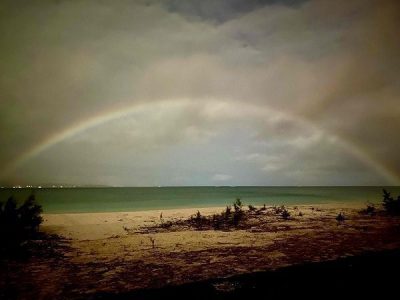
“Moon rainbow” (Photograph by Akira Oyama) =March 1, 2021
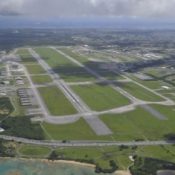
March 6, 2021 Ryukyu Shimpo
By Yukinao Chinen
Tokyo – The Japanese government is planning to enact a bill with the current Diet that would further restrict the sale of land around facilities that are important for security. They confirmed the outline for this bill on March 5. If the bill is enacted, any land within one kilometer of U.S. military or Japan Self-Defense Force (JSDF) installations will be designated as “supervised areas,” and the personal information and land utilization data of owners will be reviewed, and if it is determined that it “impedes the function of the installation,” they will order a suspension of its use. Some within the ruling Liberal Democratic Party (LDP) have voiced concerns over the restriction of private rights as well as economic impacts including land prices. In Okinawa, where many of the bases are concentrated, there is a chance that the restricted area could expand considerably.
The formal name of the bill is “The land use survey and usage restrictions for areas around important facilities and isolated islands on national borders.” The goal is to protect defense facilities from concerns such as enemy reconnaissance, invasion, or electronic interference.
A one-kilometer area around U.S. army, JSDF, and Japanese coast guard facilities, and outlying islands near national borders will be individually designated as “supervised areas,” and the government will conduct a survey of land owner information and land utilization data based on real estate registers and basic resident registers. As needed, they will request information from land owners, and will have the ability to command them to suspend use of the land. Designated areas will be determined based on the opinion of an investigative council.
The bases which also host command functions, as well as the strategically important border islands will be designated “special supervised areas,” and will require both parties engaged in a land sale to disclose their personal information as well as their intended use of the land.
If owners do not comply with an order to suspend use of the land, they can be penalized with up to two years in prison, and a fine no more than 2 million yen. If needed, Japan may also buy the land.
There are 33 U.S. military bases, 50 JSDF facilities, and 8 coast guard posts in Okinawa. Many of these neighbor populated areas, and theoretically if all of these facilities and their one-kilometer surroundings are designated as supervised areas, starting with Ginowan, which has the MCAS Futenma at its center, the area would cover most of the residential and commercial areas in Okinawa’s central region.
The LDP approved the bill at the first cabinet joint session on February 18.
Meanwhile, the Komeito Party, who rules in a coalition with the LDP, has acknowledged the aim of the bill, however due to concerns over the economic impacts, a representative from the party expressed caution over “if the measure was suitable.”
Another insider voiced their skepticism, saying, “this could lead to confining the anti-base movement.”
Prime Minister Yoshihide Suga said at a meeting with the Upper House Budget Committee on March 5, “I would like to enact this during the current legislative session by any means necessary,” indicating his strong desire to see it passed. The government has indicated they will make a cabinet decision on the bill this month.
(English translation by T&CT and Sam Grieb)
Go to Japanese
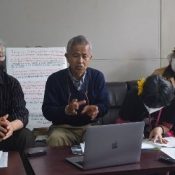
March 5, 2021 Ryukyu Shimpo
Takamatsu Gushiken, 67, who represents the Battle of Okinawa victim remains recovery volunteer group Gamafuya, is continuing a hunger strike demanding a stop to a plan to use earth from the southern region of Okinawa, where the remains of the victims of war rest, for new base construction in Henoko. On March 4, he gave an online press conference to foreign journalists stationed in Japan. Gushiken claimed that the ground also contains the remains of U.S. soldiers who went missing during the Battle of Okinawa, stating, “Simply, this is not a problem only for Japan, the U.S. has a concerned interest as well.” The hunger strike is in its fourth day, and survivors of the Battle of Okinawa have also made appearances in front of the Okinawa Prefectural Office. Gushiken stressed regarding the plan for the dirt from southern Okinawa, “It is definitely not something that can be allowed.”
At the press conference with the foreign press, there were questions such as, “If the plan in southern Okinawa is stopped, do you think it will also stop the construction plan for Henoko?” “Are you afraid of China’s military expansion?” Gushiken strongly responded, “Before the question of whether or not I approve of the base or not, there is a humanitarian issue to consider. The remains of the war-dead will be desecrated, and this is a strike to stop that.”
Additionally, Gushiken indicated that according to U.S. army data 239 soldiers went missing in the Battle of Okinawa, as well as victims from the Korean peninsula. He explained that even now remains are being found in the area around the excavation site.
On March 4, at the tent in front of the prefectural office where Gushiken continues his hunger strike, Ako Onaga, 91, from Nago, who served in the military as a nurse in the battle of Okinawa, and Itoman-native Michiko Uehara, 85, who has been searching for the remains of her missing father, both visited to show their support. Onaga spoke into a microphone about the remains that have been resting unperturbed for the past 75 years since the south of Okinawa became a battlefield, saying, “I do not want the place where blood, flesh, and bone returned to the earth to be buried at Henoko.”
Gushiken plans to continue his hunger strike through March 6. He said of his condition March 4, “My head is moving a bit slower, and I am worried that there will be lingering effects. My sense of equilibrium, but the health check came back relatively normal.”
(English translation by T&CT and Sam Grieb)
Go to Japanese
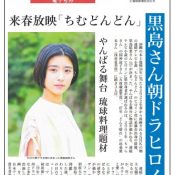
March 3, 2021 Ryukyu Shimpo
Actress Yuina Kuroshima, 23, who hails from Itoman City, Okinawa, was chosen to play the heroine in Chimu Don Don, the newest NHK morning TV drama series slated to air in spring 2022. The show commemorates the 50th anniversary of Okinawa’s return to Japan; the story takes place in Yanbaru, a town located in the northern part of Okinawa’s main island. John Kabila, a Naha City native, will narrate the series.
On March 3, Kuroshima made a live appearance on NHK’s national morning show Asaichi, from the Kunigami Village coastline in Okinawa. The actress said, “I was surprised to get the part. This will be the third morning TV drama I’ve appeared in, but I was hoping to [play the protagonist] one day, so I’m elated.”
Chimu Don Don tells the story of the main character’s ambitions of becoming a chef and succeeding in Okinawan cuisine, and her great bond with her four siblings. Full of laughter and tears, it is a tale about family and hometown. The title Chimu Don Don is an Okinawan phrase that expresses the heart beating in excitement. Kuroshima explained, “you might say, I have chimu don don for the field trip tomorrow.”
Okinawan actresses who have starred in NHK’s morning TV drama series in the past include Ryoko Kuninaka as Eri Kohagura in Churasan (2001), Aimi Higa as Natsumi Asakura in Dondo Hare (2007), and Fumi Nikaido as Oto Sekiuchi in Yell (2020).
Chimu Don Don will be the latest TV show in which Okinawa is the main subject or setting since Churasan and Jun to Ai (2012), which portrayed a heroine who grew up on Miyako Island struggling to manage a hotel.
Kuroshima was born in 1997. After modeling for Okinawa Bishoujo Zukan, she made her acting debut in the movie Himawari: Okinawa wa Wasurenai Ano Hi no Sora wo in 2013. She made her first NHK morning TV drama appearance in Massan (2014) and has since appeared in numerous dramas and commercials, including the TV series Scarlet and the historical drama Hana Moyu (2015).
In 2020, she won the 43rd Japan Academy Film Prize for Best Newcomer of the Year for the movie Katsuben!
Daisuke Habara is the screenwriter for Chimu Don Don. Habara also wrote the screenplay for Massan and the films Patchigi! and Hula Girl.
(English translation by T&CT and Monica Shingaki)
Photograph: Click to enlarge (PDF file: 880KB)
Go to Japanese











 Webcam(Kokusai Street)
Webcam(Kokusai Street)


